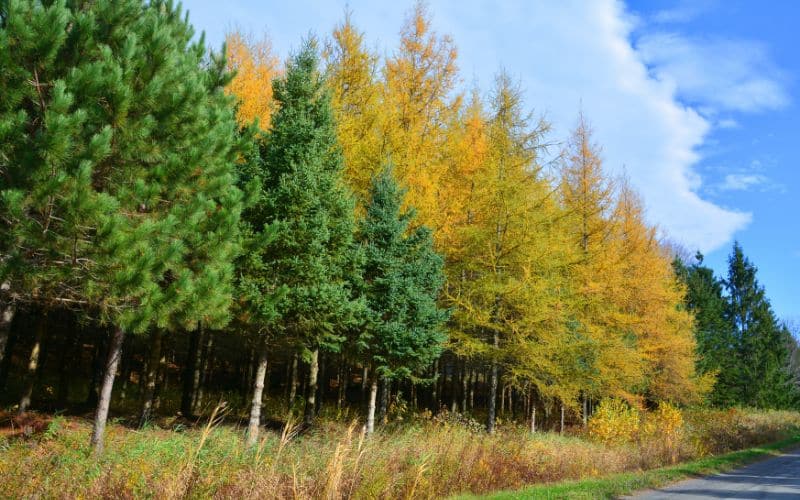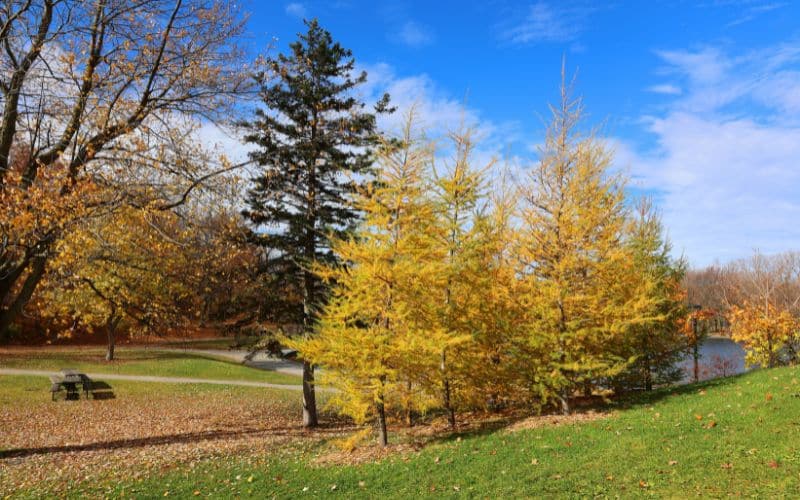
Why Tamarack Trees Are a Must-Have in Ontario
Imagine a tree that defies the ordinary, a tree that’s both a conifer and a deciduous plant, shedding its needles each fall. Meet the Tamarack, known to the science-savvy as Larix laricina. This Ontario native isn’t just another face in the crowd of trees. It’s a seasonal sensation, lighting up landscapes with its vibrant yellow needles when autumn rolls around. Intrigued? You should be. Let’s explore what sets this tree apart and why it deserves a prime spot in your outdoor space.
What Does a Tamarack Tree Look Like?
The Tamarack tree is a medium-sized conifer that can grow up to 20 meters tall. Its needles are soft, flexible, and bluish-green, turning a brilliant yellow in the fall before they drop. The bark is smooth and gray when the tree is young but turns reddish-brown and scaly as it matures.
How to Identify a Tamarack: A Quick Description
Strolling through Ontario’s great outdoors and stumble upon a tree that catches your eye? If it’s sporting clusters of needles that undergo a magical transformation from green to yellow as autumn sets in, you’ve likely found yourself a Tamarack. These needles aren’t just any needles; they grow in charming tufts and measure a dainty 2 to 3 centimeters in length. But wait, there’s more! Keep an eye out for the tree’s petite light brown cones, which usually clock in at a modest 1 to 2 centimeters.
Where Do Tamarack Trees Grow in Ontario?
If you’re on a nature walk in Ontario’s northern reaches, you’re in Tamarack territory. These native beauties have a soft spot for moist, wet soils but don’t be fooled; they’re quite the adaptable bunch. They can cozy up to various soil types without a fuss. As for their relationship with the sun, let’s just say it’s a love affair. Shade? That’s more of a complicated relationship they’d rather avoid.

What Do Tamarack Trees Need to Thrive?
Think of Tamaracks as the easy-going friends in your social circle. They’re not overly demanding when it comes to soil, but they do have a preference for moisture. Sunlight is non-negotiable; these trees crave full sun to show off their best selves. And don’t worry about those chilly Ontario winters; Tamaracks come with built-in resilience to cold temperatures.
How to Grow a Tamarack Tree in Your Backyard
So, you’ve decided to invite a Tamarack into your life—excellent choice! These trees are not just beautiful; they’re also relatively low-maintenance. First things first, pick a spot in your yard that basks in full sun; Tamaracks are sun-worshippers. As for the soil, aim for something that stays moist but isn’t waterlogged. While these trees can tolerate a bit of shade, they truly thrive when the sun is shining down on them.
If you’re planting from a seed, it’s best to start indoors in a small container and transplant it outdoors once it’s strong enough. Alternatively, you can plant a young tree directly into the ground, ensuring you dig a hole deep enough to cover its root ball. Water it generously right after planting and keep the soil moist, especially during the first few weeks.
Container-Grown Tamarack: Is It Possible?
You bet! If you’re short on yard space or just love the idea of a portable Tamarack, container gardening is a viable option. The key here is to choose a container that’s spacious enough for the tree’s root system to spread out. Look for a pot with good drainage to prevent waterlogging, which Tamaracks aren’t fond of.
Fill the container with a mix of potting soil and organic matter to ensure good drainage and nutrient content. Place the container in a sunny spot—remember, full sun is the Tamarack’s best friend. Regular watering is crucial, but don’t let the soil become soggy. If you’re growing your Tamarack in a container, you might also consider adding a slow-release fertilizer to the mix for an extra nutrient boost.
What Are the Benefits of Having a Tamarack Tree?
The Tamarack isn’t just a pretty face; it’s a multi-talented marvel. Sure, its aesthetic charm is undeniable, especially when its needles turn a radiant yellow in the fall. But beyond its good looks, the Tamarack is a workhorse. Its wood is incredibly versatile, commonly used in everything from fence posts and utility poles to the construction of boats.
But wait, there’s more! The bark of the Tamarack is rich in tannins, making it a valuable resource for tanning leather. And let’s not forget about our furry and feathered friends; while the Tamarack may not be a smorgasbord for wildlife, it does offer a cozy habitat and provides much-needed shade during those hot Ontario summers.

Common Issues: What to Look Out for When Growing Tamarack
Growing a Tamarack may be a walk in the park for the most part, but it’s not entirely without its challenges. Vigilance is key. Keep an eye out for any changes in the color of the needles. While they should turn a beautiful yellow in the fall, any other color changes during the growing season could signal a problem.
Pests like the larch sawfly and diseases such as needle cast can be a concern. If you notice the needles turning brown or falling off prematurely, it might be time to consult an arborist. Regular inspections for signs of infestation or disease can go a long way in ensuring your Tamarack stays healthy and vibrant.
Tamarack Tree Care Tips and Tricks
So you’ve planted a Tamarack and now you’re wondering how to keep this Ontario native in tip-top shape? You’re in the right place. First off, let’s talk water. Tamaracks love moisture, so make sure you’re giving your tree a good soak, especially during dry spells.
Mulching is your next best friend. A layer of organic mulch around the base of the tree not only adds a touch of visual appeal but also helps retain that all-important moisture. It’s like giving your Tamarack a cozy blanket that keeps it hydrated.
Now, what about pruning? Generally speaking, Tamaracks are low-maintenance and don’t require much in the way of cutting back. However, if you’re growing your Tamarack as more of a shrub for aesthetic reasons, a little pruning can help maintain its shape. Just make sure to do it in the late winter or early spring to avoid stressing the tree.
Conclusion: Why Tamarack Trees Are More Than Just a Pretty Face
The Tamarack tree is a true Ontario native that brings a unique blend of beauty and resilience to any landscape. Its soft needles, which turn a brilliant yellow in the fall, and its adaptability to various soil types make it a versatile choice for both novice and experienced gardeners. Whether you’re looking to plant a single tree or create a Tamarack grove, this deciduous conifer is sure to turn heads and make your outdoor space something truly special.
So, the next time you’re considering adding a new plant to your Ontario garden, why not go native and choose a Tamarack? You won’t be disappointed.








